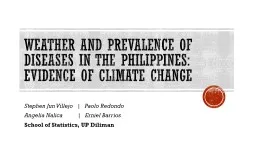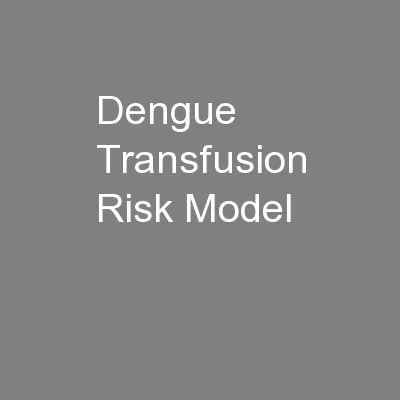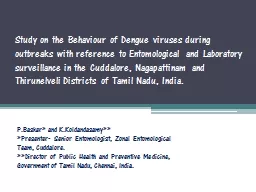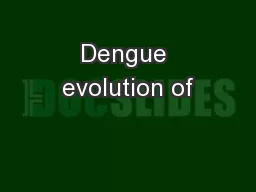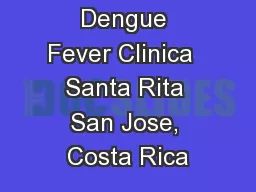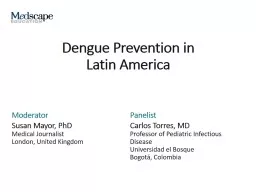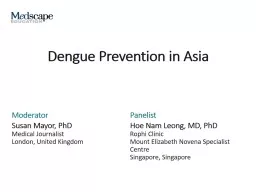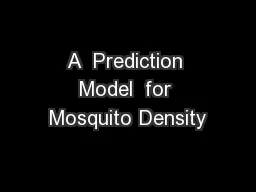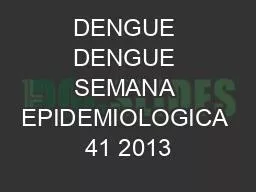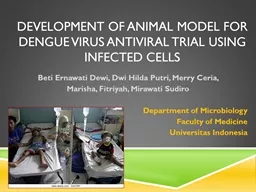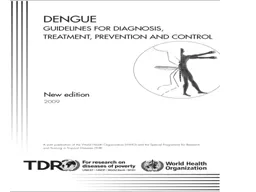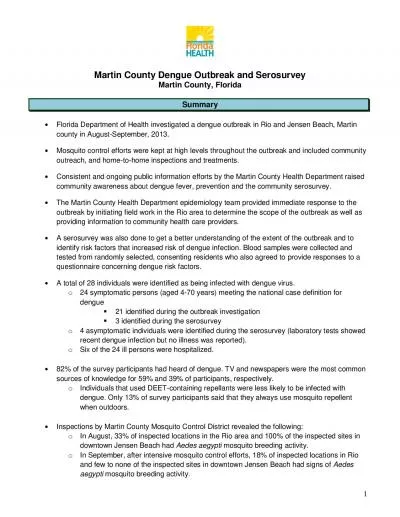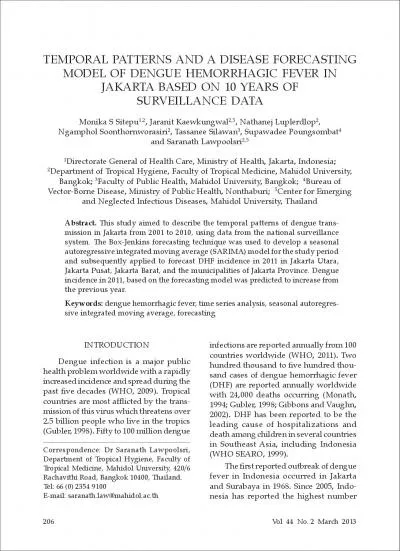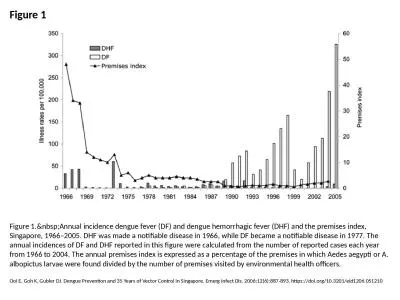PPT-Weather and incidence of dengue in the Philippines: evidence of climate change
Author : olivia-moreira | Published Date : 2019-03-02
Stephen Jun Villejo Paolo Redondo Angela Nalica Erniel Barrios School of Statistics UP Diliman Climate change and dengue According to the World Health Organization
Presentation Embed Code
Download Presentation
Download Presentation The PPT/PDF document "Weather and incidence of dengue in the P..." is the property of its rightful owner. Permission is granted to download and print the materials on this website for personal, non-commercial use only, and to display it on your personal computer provided you do not modify the materials and that you retain all copyright notices contained in the materials. By downloading content from our website, you accept the terms of this agreement.
Weather and incidence of dengue in the Philippines: evidence of climate change: Transcript
Stephen Jun Villejo Paolo Redondo Angela Nalica Erniel Barrios School of Statistics UP Diliman Climate change and dengue According to the World Health Organization climate change affects occurrence of infectious diseases apart from rapid demographic environmental social technological and other changes. This means that 1 in every 733 babies is born with this condition Although parents of any age may have a child with Down syndrome 80 are born to women under the age of 35 NICHCY Disability Fact Sheet 4 June 2010 Definition Definition Definition Defi Lyle R. Petersen, MD, MPH. Brad Biggerstaff, PhD. Division of Vector-Borne Diseases. Centers for Disease Control and Prevention. Blood Products Advisory Committee Meeting. December 14, 2010. Agenda. Arbovirus risk model. P.Basker. * and . K.Koldandasamy. **. *Presenter- Senior Entomologist, . Zonal. Entomological Team, Cuddalore.. **Director of Public Health and Preventive Medicine, Government of Tamil Nadu, Chennai, India.. virulence. Should we expect dengue virulence evolution in response to . Dengvaxia. ® . vaccination?. April 20, 2017. IDM Symposium, Bellevue, WA. Katia Koelle. Department . of . Biology. Duke University. Malorie Schuler. Objectives. Describe the clinical manifestations of dengue fever.. Explore the prevention and treatments of dengue fever.. Observe the local implications of dengue fever in the Costa Rican population.. Part 1: . Overview of Dengue. What Is Dengue?. Prevalence of Dengue in Latin America. Dengue Reported Cases in the Americas, 2016 . to 2017. Dengue Serotypes. Limitations of Dengue Surveillance. Dengue Pathophysiology and Disease Severity. Part 1: . Overview of Dengue. What Is Dengue?. WHO Dengue Case Classification. Prevalence and Disease Burden of Dengue. Dengue Serotypes. Global Distribution of Dengue, 2012. Global Dengue Transmission Map - Thailand. 1. . Lisa Grace S. Bersales, PhD. 2. and Lilian A. de las Llagas,PhD. 3. 1 . based on a study of the UP School of Statistics Research Foundation and the UP Manila College of Public Health funded by the DOST-PCHRD . Se diagnosticaron 1.950 casos probables, de los cuales 05 fueron dengue grave (0,3%), con una razón fiebre dengue/dengue grave de 389:1. El acumulado del año es de 41.938 casos, de los cuales 1,2% son dengue grave (499 casos), con una razón fiebre dengue/dengue grave de 83:1.. JAKARTA (CAPITAL CITY OF INDONESIA). DENGUE CASES IN INDONESIA. DENGUE CASES IN INDONESIA. Antiviral to dengue VIRUS (DENV). Antiviral to dengue VIRUS (DENV). ANIMAL MODEL. TITER OF DENV FROM MICE SERA. . . . Dr. AMRIT YOG DATLEY . SOURCE : WHO guidelines for diagnosis, . . treatment, prevention and control. EPIDEMIOLOGY. Dengue is most rapidly spreading mosquito-borne viral disease.. 1 Martin County, Florida Summary Florida Department of Health investigated a dengue outbreak in Rio and Jensen Beach, Martin county in August - September, 2013. Mosquito control effor ts were kep EALTH 206 Correspondence: Dr Saranath Lawpoolsri, Department of Tropical Hygiene, Faculty of Tropical Medicine, Mahidol University, 420 / 6 Rachavithi Road, Bangkok 10400, Thailand. Tel: 66 (0) 235 Ooi E, Goh K, Gubler DJ. Dengue Prevention and 35 Years of Vector Control in Singapore. Emerg Infect Dis. 2006;12(6):887-893. https://doi.org/10.3201/eid1206.051210.
Download Document
Here is the link to download the presentation.
"Weather and incidence of dengue in the Philippines: evidence of climate change"The content belongs to its owner. You may download and print it for personal use, without modification, and keep all copyright notices. By downloading, you agree to these terms.
Related Documents

